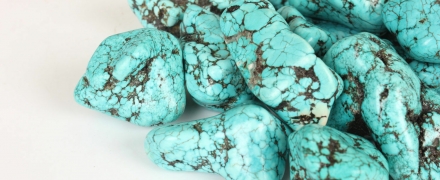open 10 am - 7 pm
laboratory is closed
Turquoise and its imitations

When we hear the word "turquoise" in our head immediately there is an idea of a light blue stone with dark veins. However, few people know that the bulk of the so-called turquoise in the jewelry market is fakes. But first things first.
What is turquoise? This is one of the most popular crafts. By its chemical composition turquoise is a hydrophosphate of copper, aluminum and iron. Zn, Cr, Ti, Ca, Ba, Be, Mg, Mn, Ni, Mo, V, Zr, Sr. are found as impurities. Turquoise has been known to man for a very long time, its most ancient developments date back to the fifth millennium BC. The formation of this stone is associated with hypergenic or low-temperature hydrothermal processes, as well as with the processes of secondary changes in copper deposits. The color of turquoise directly depends on its composition - an admixture of copper predominates, then turquoise is blue in color, and if the iron prevails in the composition, the color of the stone will be green.
Due to the high price, the percentage of natural turquoise in the jewelry market is not high enough. Most often, there are more budget-friendly ennobled specimens of turquoise or even its imitation. As a refinement of this stone, two methods are used - impregnation and staining. Impregnation can be reversible and irreversible, depending on the material of the aggregate. For processing by such methods, samples of average and lower quality are usually used, as a result, the aesthetic characteristics of turquoise are significantly improved.
There is also the term "remodeled turquoise." This is the result of pressing small turquoise chips with various plastics and additives.
As for imitations. The main thing to note here is that imitations have only a visual resemblance to turquoise and no more. As natural imitations, chrysocolla, variscite and colored howlite are usually used. Turquoise can be distinguished from them by physicochemical properties, as well as spectral and microscopic characteristics. Artificial imitations of turquoise are various glasses, enamels and of course plastic.
To distinguish real turquoise from a fake on its own is often quite a difficult task for an ordinary buyer. In this regard, we always advise you to turn to professionals in the field of gemology before purchasing.
В геммологической практике бывают весьма увлекательные случаи с диагностикой ювелирных вставок
Но помимо редкости цвета и высокой стоимости таких камней, многие розовые камни выделяются одной замечательной особенностью – они проявляют плеохроизм, то есть в зависимости от положения осмотра камня он может иметь дополнительные оттенки – оранжевый или пурпурный.
Currently, gemstones are produced by two fundamentally different technological methods - the High Pressure - High Temperature method (“HPHT”, High-pressure & High-temperature) and the Chemical Vapor Deposition (“CVD”, Chemical vapor deposition) method. The "HPHT" method is the most tested classical synthesis method, which can be used both carbon deposition on diamond from flux melts and catalytic reactions. In "CVD" synthesis, diamond growth occurs on a seed during carbon deposition mainly from a gaseous medium at relatively low temperatures and pressures.
Jewelry and precious stones are just such a category of goods, when buying which you need to pay attention to many criteria.
Sogdianite is a rather rare mineral and more often it can be found as a collection material (moreover, in systematic collections), and it is extremely rare in jewelry.






